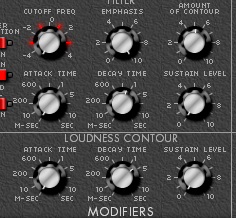
In the previous chapter of this series of tutorials, I took you through the process of making a synthesizer kick drum using a sine wave and a pitch envelope. But that isn't the only way to synthesize a kick. If you've got a hardware or software synth that has filters that self-oscillate, you've got another option.
The filters people work most with these days are much more likely to be non-self-oscillating filters, but on many older synthesizers, it was possible to set a resonance level on the filter that was so high, that it would cause the filter to oscillate at an audible frequency - even if you're not feeding any actual oscillators through it. So why is not as common to see filters with that capability these days? The down side of self-oscillating filters is that sometimes the output levels can unpredictably spike to ear-splitting, potentially speaker-damaging levels. So here's your warning. It might not be a bad idea to strap a limiter across your master bus to prevent any... unpleasantness. Or at least work with your volume at a conservative level.
One software synth that features filters that will self-oscillate is GMedia's Minimonsta, an emulation of the famous Minimoog (the original of which, of course, also has filters that self-oscillate), so that is what I will be using in this example.
1. Call up a mono instance of Minimonsta. Although not a hard, fast rule, when working with really bassy sounds, it is best to keep them in mono.
2. We won't need any of the oscillators here, so go ahead and turn them off by clicking the three blue buttons on the MIXER panel that correspond to each oscillator's volume knobs. When you press a few keys now, you should hear no sound coming out.
3. Next, head on over to the filter section and turn the CUTOFF FREQ knob all the way down, closing the filter.
4. Now set the AMOUNT OF CONTOUR (also known as ENVELOPE AMOUNT on many synths) knob to about 50%. This controls how much the filter envelope modulates (ie opens and closes) the filter.
5. Now, turn the up EMPHASIS knob (simply another name for RESONANCE) slowly, and as you get into the 60% and above area, you should start to hear the filter self-oscillate.
6. What kind of sound you are hearing depends on how your FILTER ENVELOPE settings are, so let's make sure those are where they need to be. ATTACK TIME should be set to 0% (1 ms), DECAY TIME should be set to about 50% (525 ms), and your SUSTAIN LEVEL can be turned down to 0%. If you've set everything up correctly, you should be hearing a pretty nice, vaguely 909-ish kick drum.
7. The fun part comes in experimenting. Playing with the CUTOFF FREQUENCY will take you out of kick drum territory and into more chirpy, 'laser gun' territory. Playing with the AMOUNT OF COUNTOUR knob will keep the sound in the bassy end, but will increase the filter sweep, resulting in brighter, bloopier, attack portions to the sound. And messing with your DECAY TIME knob in the FILTER ENVELOPE section with let you change your sound from something light and tight, to something sustaining and boomy, like the famous 808 kick.
Make recordings of different settings, and import them into your samplers or drum sample player of choice. Try combining them with each other, or other drum sounds in your library and you've got an almost limitless supply of synthetic kick drums to keep you busy for quite some time.




















No comments:
Post a Comment